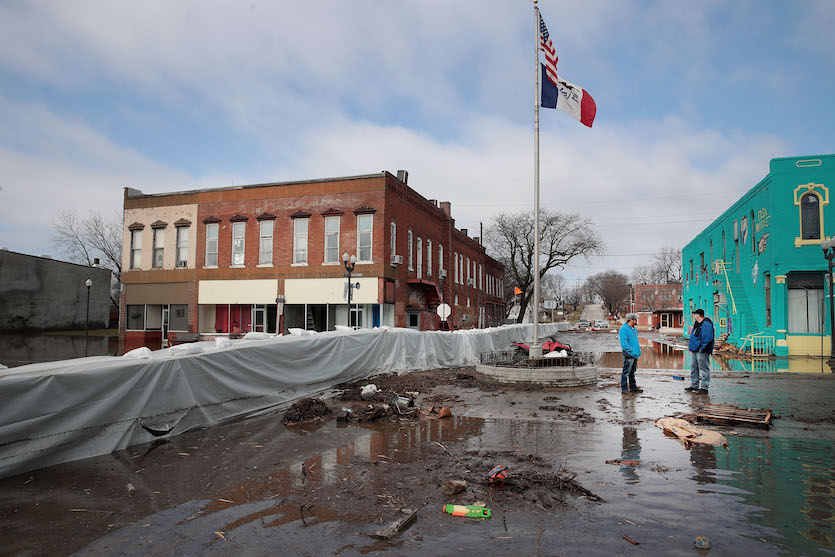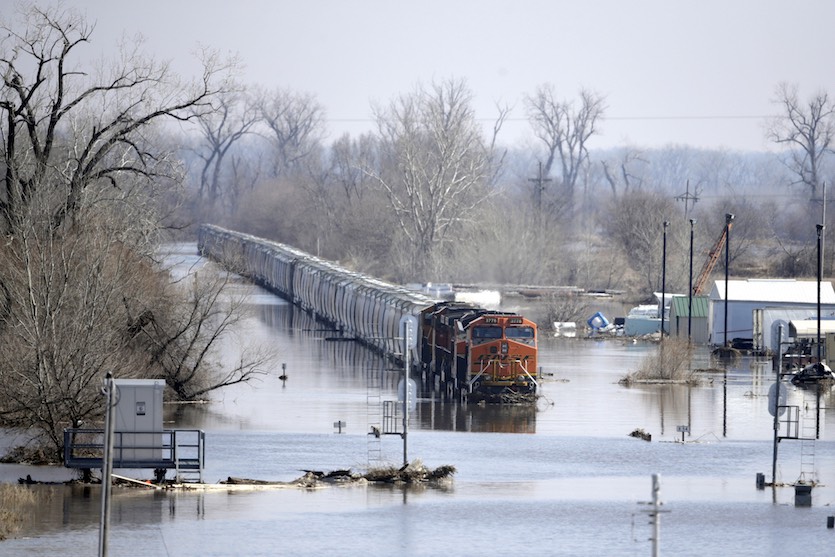| Above: This aerial photo from Tuesday, March 19, 2019, shows flooding along the Missouri River in Pacific Junction, Iowa. The U.S. Army Corps of Engineers says rivers breached at least a dozen levees in Nebraska, Iowa and Missouri. Hundreds of homes are damaged, and tens of thousands of acres are inundated with water. Image credit: DroneBase via AP. |
Costs are mounting quickly from the late-winter/early-spring flood disaster that’s assaulted the Midwest this month. Estimates from several disparate sources now suggest that the total cost of the flooding to date—including agricultural losses, road repair, and levee reconstruction—could end up in the multiple-billions-of-dollars range. At least three deaths have been linked to the flooding.
Nebraska Governor Pete Ricketts told reporters on Wednesday that preliminary damage estimates in his state alone are more than $1.3 billion, including $439 million in infrastructure losses, $85 million in private homes and business losses, $400 million in livestock and $440 million in crop losses. The total does not apparently include damage to Offutt Air Force Base, where floodwaters covered about one third of the area and inundated dozens of buildings.
To make matters worse, the Midwest is highly vulnerable to more flooding this spring, thanks to saturated soil and a large snowpack in the Upper Midwest.
 |
| Figure 1. Mud covers a street through downtown Hamburg, Iowa, as flood waters begin to recede on Wednesday, March 20, 2019. A makeshift levee that had helped protect the town from major floods in 2011 was subsequently removed because no funding was available to bring it up to specification. Image credit: Scott Olson/Getty Images. |
It will take weeks if not months to assess the full damage from the March flooding, but it appears to be the costliest U.S. weather disaster of the year thus far by a long shot.
“This is virtually guaranteed to be a billion-dollar flooding event. The question is how high will it ultimately go?” said Steve Bowen, director of impact forecasting for the insurance broker Aon.
The flooding was triggered after an intense “bomb cyclone” pushed strong winds, mild temperatures, and heavy rain across frozen, snow-covered ground on March 12-14. The result was a flash melt that clogged rivers and streams with huge ice chunks and massive amounts of water. The cyclone itself also caused widespread wind damage and blizzard-related impacts.
Trooper Viterna #480 standing next to ice chunks from the Niobrara River that were left behind after causing all kinds of damage. pic.twitter.com/nVWf5yUe12
— NSP Troop B Nights (@NSPTroopBNights) March 20, 2019
Here are some of the biggest-ticket items the Midwest is facing:
—Damaged and destroyed levees. Many levees, both small and large, have been breached or overtopped by the historic flood crests working through the region’s waterways. At least 42 locations in six states have set all-time high crests, according to weather.com.
Much of the water unleashed in and around northeast Nebraska has flowed southeast through the Missouri River watershed. At least 12 levees were breached along the Missouri in Iowa, Nebraska, and Missouri, the Des Moines Register reported on Tuesday.
Citing the U.S. Corps of Engineers’ National Levee Database, the Register noted that four of the compromised levees in Iowa protected property valued at $361 million.
The region may face “several billion dollars in just levee damage,” Pat Sheldon told the Register. Sheldon is president of an Iowa levee district that oversees 42 miles of levees along the east side of the Missouri River.
Massive flooding in the Big Lake, MO area Monday evening as the Missouri River breaches levees. Flooded homes, farms and roads are viewed from the air as far as the eye can see. Our @weatherchannel TV coverage continues today. @TevinWooten @JMichaelsNews #flooding2019 #MOwx pic.twitter.com/OTT875CSVI
— Charles Peek (@CharlesPeekWX) March 19, 2019
—Road damage. Some 1500 miles of highways across Nebraska were put under water by the flooding, noted the state’s director of transportation, Kyle Schneweis, in the New York Times on Tuesday. Along with many county roads, at least 200 miles of state highway will need repair, costing “hundreds of millions”, Schneweis told the Omaha World-Herald.
Just one 500-foot stretch of collapsed pavement near Holly Springs, Iowa, could cost $100,000 to repair, Woodbury County engineer Mark Nahra told the Sioux City Journal.
My dad @juehling5 and sister @UehlingValerie standing in what used to be County Road H between Uehling and Oakland, Nebraska. This is about a mile away from where my parents live. #NebraskaFlood #Flood19 pic.twitter.com/tsTqCgHPxw
— Liz Uehling Ready (@LizUehling) March 17, 2019
 |
| Figure 2. A BNSF train sits in flood waters from the Platte River, in Plattsmouth, Neb., on Sunday, March 17, 2019. Image credit: AP Photo/Nati Harnik. |
—Farming and ranching impacts. As reported by the Associated Press, Nebraska is facing an estimated $400 million in crop losses and $500 million in livestock losses, according to Nebraska Farm Bureau president Steve Nelson. Much of the loss is due to crops that will be delayed or will go unplanted because of soaked fields and damaged farming facilities.
“Between the costs required to rebuild infrastructure and the financial value tied to physical damage to residential and commercial properties, the agricultural impact will take a longer time to fully assess,” said Bowen. “With planting season merely weeks away, many farmers will have to play a tough waiting game to see if fields dry quick enough to allow planting to occur as close to ‘normal’ as possible. Until that occurs, the full financial cost from the floods will not be known.”
The magnitude of any further flooding across the Midwest will hinge largely on weather conditions over the next several weeks. NOAA will release its updated spring flood outlook on Thursday. We’ll cover this outlook and examine the factors that could spare or hammer the Midwest this spring in an upcoming post.



